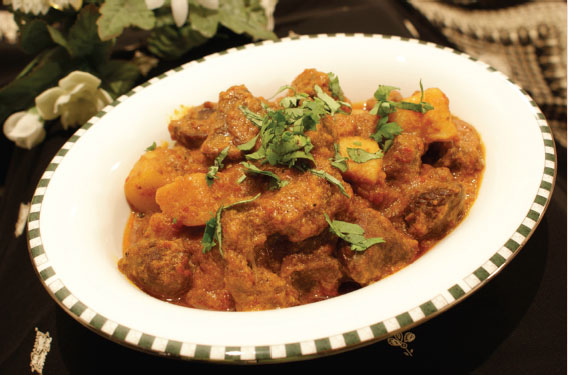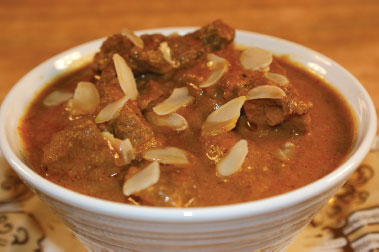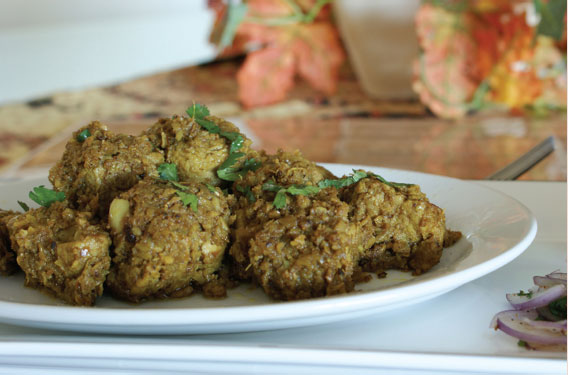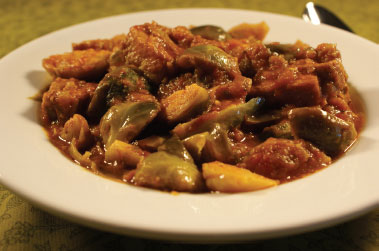
This is a dish more common in Thai restaurants, but I’ve included it because it originated with the Muslim community in India and because it is absolutely delicious. Unlike neighboring countries, Thailand managed to remain free from colonization by European powers and, as a result, its food has limited outside influences. The Thais have, however, borrowed cooking styles from other countries such as China, India and Malaysia, and Massaman Curry is a stunning example of this.
Massaman curry paste is readily available from supermarkets and Asian grocers and is relatively good. If you would like to go a step further, I have included the recipe so you can make your own.
▪ Heat the oil in a wok or heavy-based saucepan and add the ginger and cumin. Stir-fry for a few seconds and add the Massaman paste, cardamoms, cinnamon and peanuts. Stir-fry for 2 minutes.
▪ Stir in half the coconut cream and bring to a simmer. Cook on medium heat, stirring often, until the cream is completely absorbed into the paste and the oil starts to separate from the mixture. Repeat with the remaining coconut cream.
▪ Stir in the coconut milk and bring to a simmer. Simmer, stirring often, for about 10 minutes until the sauce has reduced.
▪ Stir in the sugar, fish sauce, tamarind and meat. Bring back to simmer and cook on low heat for another 10 minutes. Do not boil vigorously as the coconut sauce may separate.
▪ Serve with rice and chapatis.
12 dried chilies, deseeded and soaked
1 whole garlic bulb, cloves peeled
2 oz (60 g) sliced shallots 1 tbsp ground coriander
1 tsp ground cumin
1 tsp ground pepper
1 tsp lemongrass, chopped
1-inch (2.5 cm) piece of galangal, peeled, chopped
1 tsp kaffir lime zest
1 tbsp scraped, chopped cilantro roots
3 tsp salt
1 tsp shrimp paste (belacan)
2 tbsp olive oil
Grind or process all the ingredients until you have a fairly smooth paste. Place in a clean jar, pour a little oil over the top and keep in the fridge for up to a week.
Vindaloo is the Portuguese name for vinegar and garlic. Perhaps it should be vinegar and chili because vindaloo is notorious for being hot, hot, hot, and for some, the hotter the better. However, for a good vindaloo, the heat should be balanced with other spicy flavors.
Traditionally, a combination of clear and dark vinegars is often used to make vindaloo. The clear vinegar is made from coconut and the dark from molasses. Balsamic vinegar works well.
▪ In a small bowl, mix together the garlic, ginger, chilies, 1 teaspoon of the garam masala, turmeric, chili powder and vinegar.
▪ Heat the oil in a deep, heavy-based frying pan and add the spice mix. Stir-fry for about a minute or until aromatic.
▪ Add the curry sauce and salt and bring to a boil. Cook on high for about 5 minutes until thickened.
▪ Add the meat and bring back to a simmer. Stir in the remainder of the garam masala and fenugreek leaves, if you are using them. Simmer for 5 minutes or until the oil separates from the sauce.
▪ Serve.
From the streets of Bombay (officially Mumbai, since 1995) comes this delicious combination of tender beef and potato in a beautifully spiced sauce made silky smooth by the addition of a little coconut milk. If you don’t have coconut milk in the pantry, evaporated light milk or a little cream will work well.

▪ Cook the potato in boiling salted water for about 10 minutes until just tender. Drain.
▪ Meanwhile, heat the oil in a deep, heavy-based frying pan and stir in the tomato paste and turmeric. Stir around in the hot oil for 10 seconds and add the curry sauce.
▪ Bring to a boil and cook on high for about 5 minutes until the sauce is thick and starting to release the oil.
▪ Stir in the beef, salt, chili powder, cooked potato and coconut milk. Bring back to a boil and simmer gently for about 10 minutes, stirring often.
▪ Add the garam masala and tamarind, simmer for a minute, and serve.
A mildly spiced but flavorsome dish, Beef Badami is inspired by rich Mughal influences. The ground almonds and cream make for a deliciously creamy sauce while the lightly toasted flaked almonds add a contrasting crunch. A tasty and impressive dish fit for a king.

▪ Heat the oil in a deep, heavy-based frying pan and add the cardamom, cinnamon and cloves. Stir-fry on medium heat for a minute, add the cumin and coriander, and fry for a few seconds more.
▪ Add the curry sauce, salt and chili powder, and bring to a boil. Cook on high heat, stirring, for about 5 minutes until the sauce thickens.
▪ Stir in the beef and ground almonds. Bring back to a boil and simmer for 5 or 6 minutes, stirring often. Add the cream and simmer for another 3 minutes.
▪ Serve sprinkled with the sliced or slivered toasted almonds.
Another Punjabi delicacy regularly enjoyed at Punjabi roadside restaurants (or Dhabas), this dish has little in common with the chicken dish of the same name. It is robustly spiced, though not too hot, very easy to cook and extremely good. Pork Tikka can be served as a main course with a yogurt dish to temper the spices, or as an appetizer with a crisp salad.

▪ Process or finely chop the onion, garlic, ginger and chilies and combine with the remaining marinade ingredients.
▪ Trim the pork fillet and slice into 1-inch (2.5 cm) chunks. Place in a bowl with the marinade, cover and refrigerate for about 2 hours or overnight. Remove from the fridge about 30 minutes before using.
▪ Heat half the oil in a deep, heavy-based frying pan, add the turmeric, stir once and add the curry sauce. Bring to a boil and cook for about 5 minutes until thick.
▪ Turn down the heat, stir in the paprika and salt, and simmer gently while cooking the pork.
▪ Heat the remaining oil in a karahi or large frying pan, and add the meat and marinade. Stir-fry on high for 3–4 minutes until the liquid has evaporated and the meat is starting to brown.
▪ Add the meat mixture to the sauce, scraping out all the crusty pieces that will have stuck to the pan. Stir-fry again on high for 3–4 minutes.
▪ Turn down the heat and simmer, stirring often, for about 15 minutes or until all the liquid has evaporated and the mixture is rich and dark.
▪ Stir in the garam masala and stir-fry on low heat for a minute or two. Serve sprinkled with the cilantro.
Mangalore is an Indian coastal state south of Goa. Its cuisine is a product of many influences, including those of Goa, Portugal and the Middle East. This dish is based on the Mangalorean style of cooking with the abundant use of roasted spices for aroma and flavor, and the use of tamarind and vinegar for balance and a tasty tang. It doesn’t have the heat of the Goan vindaloos, so the flavor of the spices really shines through.
▪ Roast the spices in a small pan over medium heat for about a minute or until aromatic. Remove from the pan and cool. Grind to a fine powder in a pestle and mortar or electric grinder.
▪ Trim the pork fillet and slice into large chunks about 1¼-inch (3 cm) in size. Combine the pork with 1 tablespoon of the oil, the spice mix, tamarind, onion and garlic.
▪ Heat the rest of the oil in a deep, heavy-based frying pan and add the curry sauce, salt and paprika. Bring to a boil and cook on high heat for about 5 minutes until thick and starting to release the oil. Lower the heat and simmer gently while cooking the meat.
▪ Heat a karahi or frying pan and stir-fry the meat mixture for about 3 minutes until browned. Add the meat to the thickened sauce, scraping the karahi to remove all the crusty pieces, and stir in the vinegar and roast spices.
▪ Cover and simmer gently for 10 minutes, stirring once or twice. Remove the lid and simmer for another 10 minutes until the meat is cooked through. Add a little water if the mixture becomes too dry or sticks to the bottom of the pan during this time.
▪ Stir in the green chili and serve.
A Punjabi innovation, this dish combines the richness of pork with the freshness of brussels sprouts, and it is a combination that is incredibly good. Traditionally, the dish would be made with pork shoulder or rib, with lots of bone and fat to “roast” the spices and add plenty of flavor. This recipe uses pork fillet, making it a healthier option, and is quick and easy to prepare. It is only worth making this dish around winter when fresh, sweet brussels sprouts are in season. At other times of the year, try a variation with shredded cabbage or spinach.

▪ Trim the pork fillet and slice into 1-inch (2.5 cm) pieces. Place in a bowl with 1 tablespoon of the oil, half the turmeric, the chilies, garlic and ginger. Mix well and set aside.
▪ Slice off the exposed end of the stalks and remove outer leaves from the brussels sprouts. Rinse under cold water and cut into quarters. Place in a microwave-proof container with 2 tablespoons of water, and microwave on high for 3 minutes.
▪ Heat the remaining oil in a deep, heavy-based frying pan and add the tomatoes, salt and remaining turmeric. Cook, stirring for 2 or 3 minutes until the tomato is pulpy.
▪ Stir in the pork and stir-fry on medium to high heat for 3 minutes. Add the curry sauce and brussels sprouts to the pan, and bring to a boil, stirring often. Cover the pan and simmer for 10–12 minutes.
▪ Remove the lid and simmer for another 5 minutes, stirring often, until the liquid has evaporated.
▪ Stir in the garam masala, heat for a minute and serve.
A colorful and tasty dish, Chili Pork is inspired by Chinese influences and will appeal to those who relish the flavor and aroma of fresh chilies. By using the larger (often called Thai) chilies, the color and flavor are achieved without the extra heat. Use a combination of hot and mild chilies if you prefer a hotter dish.

▪ Combine the pork, garlic, ginger, turmeric and 1 tablespoon of the oil in a bowl.
▪ Heat 1 tablespoon of the oil in a deep, heavy-based frying pan and add the pork. Stir-fry the meat for 3 minutes on high. Add the curry sauce, chili powder and salt, and simmer for 10 minutes.
▪ Meanwhile, heat the remaining oil in a separate pan and add the sliced chilies and red pepper. Stir-fry on medium heat for 3 minutes until starting to color.
▪ Stir the fried chilies and red pepper into the pork mixture and simmer for another 5 minutes before adding the tomato and garam masala.
▪ Simmer gently for 5 minutes. The sauce should be very thick and the oil should be separating from the sauce.
▪ Serve sprinkled with the cilantro.